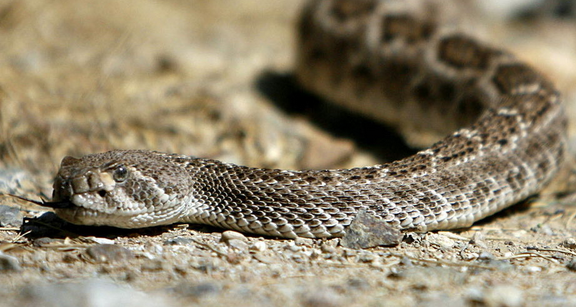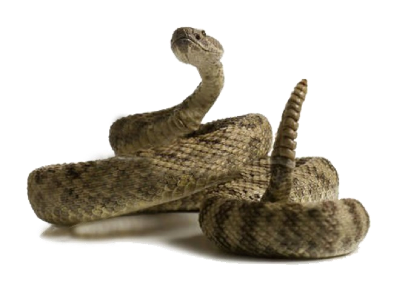Tuesday, March 11 2025
Did you know that thousands of people in the United States are struck each year by venomous snakes?! When bitten, venom travels through the bloodstream, destroying tissue and causing swelling, internal bleeding, and intense pain. Some bites are fatal. Don't take a chance! Turtleskin SnakeArmor can help protect men and women against deadly snake fangs — and protect your dog, too! Turtleskin brand is made in the USA and tested with live rattlesnakes.
 TurtleSkin SnakeArmor's patented technology produces the tightest weave ever made with high-strength fibers. Its weave is so tight that snake fangs can't puncture it— not even large diamondback rattlesnakes! Constructed from a patented super-tight weave of high-strength ballistic fibers and polyester, the fabric itself is snake proof! In addition to protecting against snake fangs, your legs are also protected against briars, thorns, and sticks. Turtleskin brand snake protection is cool, comfortable, water and wind resistant, and lighter than other brands. Choose from snake gaiters that protect from your knee to your ankle, or snake chaps that can protect your entire leg from hip to ankle, or snake pants that offer snake bite protection from the knee down. Turtkeskin is available in a variety of colors and uni-sex sizes, and are ideal for both women and men. Vests and neck gaiters are available for dogs. TurtleSkin SnakeArmor's patented technology produces the tightest weave ever made with high-strength fibers. Its weave is so tight that snake fangs can't puncture it— not even large diamondback rattlesnakes! Constructed from a patented super-tight weave of high-strength ballistic fibers and polyester, the fabric itself is snake proof! In addition to protecting against snake fangs, your legs are also protected against briars, thorns, and sticks. Turtleskin brand snake protection is cool, comfortable, water and wind resistant, and lighter than other brands. Choose from snake gaiters that protect from your knee to your ankle, or snake chaps that can protect your entire leg from hip to ankle, or snake pants that offer snake bite protection from the knee down. Turtkeskin is available in a variety of colors and uni-sex sizes, and are ideal for both women and men. Vests and neck gaiters are available for dogs.
- TurtleSkin SnakeArmor Snake Gaiters are constructed from a super-tight patented weave of high-strength ballistic fibers and polyester. Many brands of snake gaiters are heavy, stiff, and bulky, but at 6 ounces each, these gaiters are light weight, yet are tested to repel even large rattlesnakes. And the gaiters fold compactly to approx. 8 x 8 x 2 inches for backpacking and to save storage space. TurtleSkin SnakeArmor Snake Gaiters stopped a simulated snake strike of paired 0.05” diameter needles weighing a total of 150 grams at 0.63 joules. The system also stopped a simulated snake bite of a 0.042” diameter needle at 1.49 pounds with a penetration limit of 0.03”.

- TurtleSkin SnakeArmor Snake Chaps weigh only about 2 pounds, and are comfortable to wear all year round — not too hot or heavy to wear during warmer months. They are also wind and water resistant, making them a great option to wear during wet or colder seasons. This premium protective product is the lightest and softest snake chaps on the market. Below-the-Knee snake chaps as well as Turtleskin hunting pants offer fabric above the knee that keeps your pants dry and clean and snake protection from knee to ankle. TurtleSkin SnakeArmor Total Protection Snake Chaps provide snake protection from your ankle up to your thigh, which is ideal for working in swampy areas.
- A snake bite directly to your dog's chest or neck can be fatal, so protecting these vital areas while hunting or hiking is critical. Made from the same material as lightweight Turtleskin SnakeArmor gaiters and chaps for people, the Turtleskin DogArmor hunting vest and neck gaiter protects from snakes, and from thorns, briars, and sticks, too. Upland cover can be brutal on your faithful dog's underside, leaving it red and raw after a day of hunting, but now you can provide chest, belly and neck protection for man's best friend!

Whether you're working or playing in the great outdoors, stay safer with Turtleskin SnakeArmor!
Sunday, July 17 2016
“The number of reported bites usually hovers in the double digits through May, June and July and then jumps to about 30 in August and September,” said an employee at the Arizona Poison and Drug Information Center. “It’s about a bite a day during those months before tapering off in October and November.”
Yikes! A bite a day in just southern Arizona alone?! The Grand Canyon state is home to 13 species of rattlesnakes, with eight or nine species living in Southeastern Arizona, depending on how the region is defined, and on average, 150 to 160 rattlesnake bites are reported every year. Multiply those statistics by all the states where poisonous vipers live, and you know why you've got to be careful this summer!
Rattlesnakes typically come out of their winter dens in March or April, and return in November. They range far and wide — from deserts, canyons and forests to urban backyards. Some rattlers slither a mile or more from their dens to places where they spend the summer— many times in the same places where humans and dogs hike, camp, hunt and live. Some rattlesnake bites are so-called “dry bites” in which no venom is injected. Sometimes the dry-bite rate can be 20 percent. It all depends on the age of the snake, if it has recently eaten (and used its venom on the rodent it bit), and other factors.
“I’ve been a little bit paranoid just walking around the house now,” admits a home owner in Anaheim Hills, California who was hospitalized after she was bit in her own bathroom by a rattlesnake. Her neighbor’s Beagle was also bitten the week before by a baby rattlesnake. Both received anti-venom and are recovering. Fire officials say the appearance of rattlesnakes in Orange County is no rare occurrence. “The reason why we’re seeing more and more snake calls, and snake incidents, is because it’s so dry. It’s the fourth year of a serious drought, and it’s been so hot lately. These snakes are trying to find water.”
Rangers in Boulder County are warning hikers and cyclists to be on the lookout for snakes in the grass after a Wyoming resident who'd been visiting friends in Colorado was bitten on the shin by an adult snake that was about three feet long. The friends reportedly got off their bicycles and were crossing an open grassy area to go to a different trail when the woman was bitten. The victim was airlifted to a nearby hospital, treated with anti-venom, and was released.
"Contrary to many people's understanding, rattlesnakes do not deliberately harm people. They will only strike if threatened; otherwise, rattlesnakes will do everything possible to avoid a human encounter." Officials in Boulder caution people to watch where they step, particularly when in rocky or grassy open areas, and to be careful about what you wear. Especially this time of year the weather is beautiful and you want to wear shorts, but leaving one's legs bare and ankles exposed may not be wise for people who leave the traveled trails. Always keep your dogs on a short leash when hiking to minimize the opportunity for them to poke their nose where a prairie rattlesnake might be hiding.
Snake bite victims are generally not doing anything wrong. They are just in the wrong place at the wrong time— working in the yard or around a wood pile, or outside enjoying the summer— and nothing could have been done to prevent the bite. But if you are purposely going into known snake country to hike or hunt, the best prevention is to wear snake gaiters or snake proof boots.
If the worse happens, the best response to a bite is to go immediately to a medical facility for examination and treatment with anti-venom if needed. No cutting, no sucking, no tourniquets. Just get to a hospital. Other tips include not putting ice on the bite, and any limbs that are bit, whether it be on the arm or the leg, should be kept below the heart.
Sunday, June 22 2014
The official start of summer means more people are generally spending more time outdoors, which also means their dogs are with them, especially when hiking and camping. Rising temperatures can also mean more snakes are active, resulting in the risk of more snake bites for both humans and animals. Of course if you spend a lot of time in "snake country" (could be the de sert or woods, depending on where you live) you either wear snake proof boots or snake gaiters over your own thick leather boots, but what about Fido? Unfortunately there are no such products for canines, but even if there was, you might have a hard time convincing your pooch to wear them. So what can you do to keep your dog safe from snake bite? Check out rattlesnake avoidance training! sert or woods, depending on where you live) you either wear snake proof boots or snake gaiters over your own thick leather boots, but what about Fido? Unfortunately there are no such products for canines, but even if there was, you might have a hard time convincing your pooch to wear them. So what can you do to keep your dog safe from snake bite? Check out rattlesnake avoidance training!
"Prevention is your number one line of defense in protecting your dogs from venomous snakes. When dogs and their owners go hiking, camping, or to the park where dogs go off leash, this training teaches them to be fearful of the rattlesnake. It also protects the people as well, as the dog becomes an alert system. This training has proven to be an effective tool in teaching rattlesnake avoidance to all dogs from Great Danes to Chihuahuas," explains John Potash, co-founder and co-owner of Get Rattled.
Get Rattled is a unique training clinic designed specifically to teach dogs on rattlesnake avoidance. The clinic has been in business for 14 years and has successfully trained more than 5,000 dogs. Potash is licensed by the Nevada Department of Wildlife and has 24 years of experience working with venomous snakes and wildlife in areas of animal control, wildlife rescue, and public education. He works with skilled dog trainer Willie J. Stevens Jr. who has more than 20 years of experience training and judging pointing dogs. The training is held at Olive Hills Kennels in Knights Landing, California. If you live in a different state that is known to have a problem with snakes, ask around or search cyberspace for a similar training program near you.
But what happens if your beloved canine gets bitten despite your best efforts to protect him or her? Dogs are usually bitten on their front limbs, neck, head, or face so look for bleeding and severe swelling in those areas. A dog will often act as though something is bothering them by rubbing or licking the affected area. After some time, the venom may produce nausea, vomiting, and the dog can seem lethargic. If you see a snake bite happen or notice these symptoms, keep your dog calm and get to a vet right away.
 If your vet determines that your dog has been bitten by a rattlesnake, he or she can administer an anti-venom shot. Veterinarians in areas that are experiencing higher than usual incidences of snake bit in dogs also recommend a vaccine booster shot every six months. The vaccine is important not only because it can help limit the damage done by snakebite, but also because it costs far less than the anti-vemon. Although the vaccines cannot prevent a dog from suffering a snakebite, and they aren’t effective against all snakes found in all states, vets have reporting seeing plenty of dogs who are alive because they received the vaccine booster. The vaccine is effective against bites from western rattlesnakes and timber rattlesnakes, but not eastern rattlesnakes or water moccasins. If your vet determines that your dog has been bitten by a rattlesnake, he or she can administer an anti-venom shot. Veterinarians in areas that are experiencing higher than usual incidences of snake bit in dogs also recommend a vaccine booster shot every six months. The vaccine is important not only because it can help limit the damage done by snakebite, but also because it costs far less than the anti-vemon. Although the vaccines cannot prevent a dog from suffering a snakebite, and they aren’t effective against all snakes found in all states, vets have reporting seeing plenty of dogs who are alive because they received the vaccine booster. The vaccine is effective against bites from western rattlesnakes and timber rattlesnakes, but not eastern rattlesnakes or water moccasins.
Not all dog owners need to worry about vaccinating their pet, especially if your furry family member is primarily an indoor animal. But if Rover lives outside, like a hunting dog, or if your pet tends to wander around or is your hiking companion, talk to your local veterinarian about getting the vaccine.
|